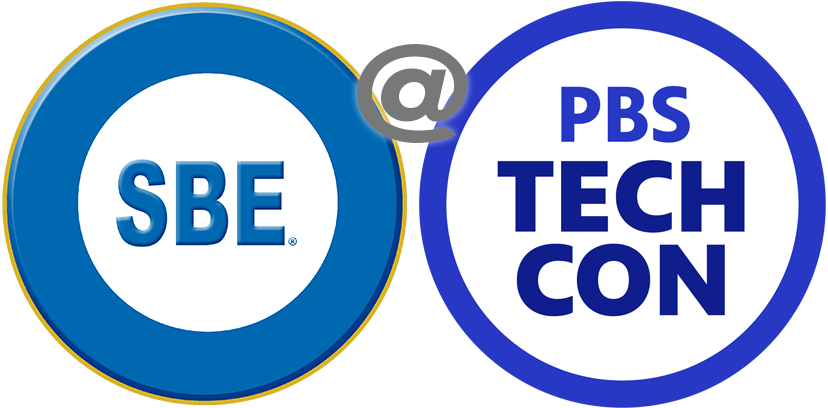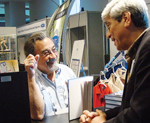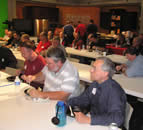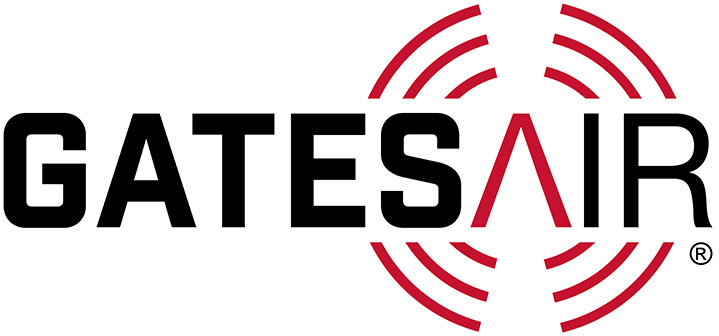SBE at PBS TechCon 2020
On March 11, the NAB announced that the 2020 NAB Show will not be held in April because of the coronavirus pandemic. With that, the SBE has cancelled all its events originally scheduled in April. As the NAB explores presenting the convention at a later date, the SBE will work with the NAB to possibly reschedule its convention events as well.

SBE Tutorials at PBS TechCon
After a successful partnership in 2019, the SBE is again providing an educational program for broadcast/media engieers as part of the PBS TechCon, "Beyond TechCon" series. Two sessions will be held at the MGM Grand Hotel and Casino (Conference Center rooms 301/302), on Saturday, April 18.
The morning session focuses on audio quality, Capturing Audio for Broadcast - an Expert Tutorial. Most have a fair grasp of the basics of microphones and how to capture sound, but there are nuances in capturing the best possible audio. The afternoon session, Rebuilding Our Over-The-Air TV Infrastructure, focuses on the decision points of NextGen TV implementation. Program details and information about our speakers can be found below.
Register for One or Both!
• Full Day (both sessions) $75 for SBE Members, PBS and NPR Member Station employees
• Morning Session: Capturing Audio for Broadcast $50 for SBE Members, PBS and NPR Member Station employees
• Afternoon Session: Rebuilding our Over-the-AirTV Infrastructure $50 for SBE Members, PBS and NPR Member Station employees
Non-member cost: $70 for each session or $115 for both.
Coffee provided. Lunch is on your own. The MGM Grand has a large food court and other dining choices.
The SBE sessions at PBS TechCon are supported by these SBE Sustaining Member companies:
Morning Session
9:00 a.m. - 12:00 p.m.
Capturing Audio for Broadcast - an Expert Tutorial
To our viewers and listeners, audio quality is first and foremost. Nothing more affects psycho-acoustical perceived quality of a radio show, concert, video, film, recording or live event more than accurate and well-defined sound. Most of us have a fair grasp of the basics of microphones and how to capture sound, but most of us recognize that if we’re not the expert doing this every day in all sorts of settings, what we capture usually isn’t the same quality as that captured by professionals – even though we use the same microphones and mixers. It’s not an easy topic to address and there is a fair amount of nuance and complexity. One needs an instructor who is deeply experienced and can describe and explain this in terms broadcast engineers can best relate to, meaning a fair amount of physics and explanations of why things work the way they do.
Steve Savanyu has a penchant for clear and precise explanation of the most esoteric and technical aspects of transducer physics and technology. He is an adjunct Professor of Audio for Video at Kent State University. We’ve asked Audio Technica, a major manufacture of microphones, to facilitate and support this program with the equipment necessary to demonstrate and teach the subject of audio “micing” and mixing. We have never met anyone -- who after seeing this program -- didn’t leave with new tricks, a list of things they’ll do differently in the future and a much deeper understanding of the art and science of capturing audio.
Presenter: Steve Savanyu; Director of Education Services; Audio Technica
Afternoon Session
1:30 p.m. - 5:30 p.m.
Rebuilding Our Over-The-Air TV Infrastructure
Experts will discuss the modulation/workflow profiles that are most realistic for various uses: datacasting, mobile file downloads, low and high resolution content, emergency communication and potential other uses of NextGen transmission.
Home and Master TV Antenna Systems Updated
Over-the-air reception of ATSC 3.0 is important for some cable headends, satellite and other MVPD services. It's also important back at the station, and part of NextGen is that stations, in particular in times of emergency, will likely share content and other data. Post repack, and with the conversion to ATSC 3.0, the RF environment for reception has changed. Strong signals from adjacent LTE/5G spectrum and single-frequency network boosters is somewhat more complex than back in the analog TV days. Test equipment for maximizing the reliability of OTA reception is in the works. A new generation of outdoor and indoor antennas is in the offing. This joint presentation covers the design of simple to master antenna systems, including amplifiers, modulators, splitters and filters.
Presenters: John Kipp, Broadcast Sales Manager, Toner
Adam Long, VP of Product Management, Channel Master
Rob Privett, Vice-President of Sales, Channel Master
The Business of NextGen Broadcast
The economics behind NextGen TV are not as discussed as the technology. We are on track, by 2024, to enter a world where digital advertising moves ahead of traditional advertising. As an industry, we are moving to a NextGen Broadcast distribution platform that moves our industry further into digital media - actually broadcasting interactive content - where in the past we sought to drive viewers to our digital streaming and news services. What are the drivers for adoption? How fast or slow will it likely take? How does that impact stations and broadcast engineers?
Presenter: Rick Ducey; Managing Director; BIA Advisory Services
Brief presentation during the break
3:00 p.m. - 3:15 p.m.
100 Years of Broadcasting – KDKA - Pittsburgh
Presenter: James O’Neil
Practical Guidance from the Phoenix Model Market Station as described in the Pearl’ TV/Phoenix Partnership NextGenTV Host Station Manual
While the ATSC 3.0 transition picks up steam, the process of conversion has become somewhat clearer. What last year were questions are now answers largely found in Pearl TV's Host Station Manual. Contained within is guidance on sharing spectrum to clear channels, licensing, equipment, configurations, selection of MOD/CODs, monitoring, logging, controlling, various video and audio enhancements including HEVC, HDR, WCG, and HFR as well as AC-4, and much much more.
This tutorial is designed to introduce broadcast engineers to the wide knowledge base, identify the key understandings and concepts, and provide the knowledge to frame questions and identify the resources for assistance. The SBE will soon offer certification for NextGen Broadcast/ATSC 3.0. This is a good place to start, or fine tune, your understandings in preparation for the SBE certification exam.
Presenters: David Folsom, Consultant, Pearl
Pete Van Peenen, Consultant, Pearl
MGM Grand Conference Center third floor overview
The SBE@PBS TechCon tutorials are organized and moderated by SBE Fellow, Fred Baumgartner, CPBE, CBNT.
Go to the News and Headlines Archive













